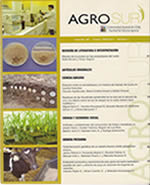Effect of different irrigation levels on the yield of rose hip (Rosa canina L.), in South-Central Chile
Main Article Content
Abstract
The water resource is the limiting factor in rainfed areas for the introduction of new production alternatives. The objective of this field experiment was to evaluate the effect of different water levels on yield components of rose hip orchards (Rosa canina L.) located in South-Central Chile, during the 2011-2012 growing season, in an Aquic Palexeralfs soil under drip irrigation. The field experimental design was completely randomized with four water treatments set as a function of applied irrigation depth (ID) in the farm (ID) : 0,25 ID; 0,5 ID; 1 ID (control) and 2 ID with three replicates of five plants. Applied water volume, soil water content, stomatal conductance, yield components, industrial yield and water productivity were determined. Results showed that the water requirements of rose hip were lower and equivalent to supplementary irrigation during the period of maximum evapotranspiration. The different water levels did not affect the physiological parameters and yield components. Application of the 50% irrigation depth achieved a good dry pulp yield and it is an adequate irrigation strategy for rainfed areas with water scarcity.

